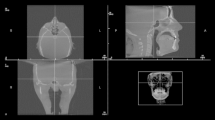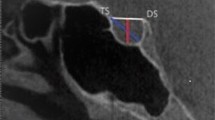Abstract
Purpose
The main aim of the present study was to investigate the dimensions and morphological appearance of the sella turcica in cleft lip and palate patients using cone-beam computed tomography (CBCT) images, compared to non-cleft individuals.
Methods
CBCT images of 40 (20 females and 20 males) cleft lip and palate patients and 60 (27 males and 33 females) non-cleft individuals were assessed, retrospectively. The linear dimensions (depth, diameter and length) of the sella turcica and inter-clinoid distance were measured. Sella turcica shapes were examined in the cleft lip and palate patients and non-cleft individuals. Non-cleft individuals were divided into skeletal malocclusion classes. All variables were analyzed using the Kruskal–Wallis test, Mann–Whitney U tests and Chi-square test.
Results
No significant difference was observed between individuals with and without cleft in the linear dimensions (depth, diameter and length) of the sella turcica (p > 0.05). However, a significant difference was found in the inter-clinoid distance between patients with cleft and non-cleft individuals (p < 0.05). Comparison of the sella turcica shape between skeletal malocclusion classes and patients with cleft showed significant differences (p < 0.05).
Conclusions
No significant difference was determined in the depth, diameter, or length of the sella turcica in cleft patients when compared with non-cleft individuals. The inter-clinoid distance was lower in cleft patients than in non-cleft individuals, and this difference was statistically significant.

Similar content being viewed by others
Change history
23 May 2020
In the original publication of the article, the given name and family name of the author were swapped. The correct author name is given in this erratum,
References
Abdel-Kader HM (2007) Sella turcica bridges in orthodontic and orthognathic surgery patients. A retrospective cephalometric study. Aust Orthod J 23:30–35
Alkofide EA (2008) Sella turcica morphology and dimensions in cleft subjects. Cleft Palate Craniofac J 45:647–653
Alkofide EA (2007) The shape and size of the sella turcica in skeletal class I, class II, and class III Saudi subjects. Eur J Orthod 29:457–463
Andredaki M, Koumantanou A, Dorotheou D, Halazonetis DJ (2007) A cephalometric morphometric study of the sella turcica. Eur J Orthod 29:449–456
Axelsson S, Storhaug K, Kjaer I (2004) Post-natal size and morphology of the sella turcica. Longitudinal cephalometric standards for Norwegians between 6 and 21 years of age. Eur J Orthod 26:597–604
Becktor JP, Einersen S, Kjaer I (2000) A sella turcica bridge in subjects with severe craniofacial deviations. Eur J Orthod 22:69–74
Canıgür Bavbek N, Tekin Kaymaz F, Türköz Ç (2019) Evaluation of the cranial base and sella turcica morphology in patients with unilateral cleft lip and palate. Acta Odontol Turc 36:33–40
Cesur E, Altug AT, Toygar-Memikoglu U, Gumru-Celikel D, Tagrikulu B, Erbay E (2018) Assessment of the sella turcica area and skeletal maturation patterns of children with unilateral cleft lip and palate. Orthod Craniofac Res 21:78–83
Chauhan P, Kalra S, Mongia SM, Ali S, Anurag A (2014) Morphometric analysis of the sella turcica in North Indian population: a radiological study. Int J Res Med Sci 2:521–526
Cheng Y, Wang C, Yang F, Duan Y, Zhang S, Wang J (2013) Anterior clinoid process and the surrounding structures. J Craniofac Surg 24:2098–2102
Gargi V, Ravi Prakash SM, Nagaraju K, Malik S, Goel S, Gupta S (2019) Radiological analysis of the sella turcica and its correlations with body mass index in a North Indian population. Oral Radiol 35:184–188
Ize-Iyamu IN (2014) Sella turcica shape, linear dimensions, and cervical vertebrae staging in preorthodontic patients in Benin City, Nigeria. Sahel Med J 17:151–158
Kjaer I (2015) Sella turcica morphology and the pituitary gland—a new contribution to craniofacial diagnostics based on histology and neuroradiology. Eur J Orthod 37:28–36
Korayem M, Alkofide E (2015) Size and shape of the sella turcica in subjects with Down syndrome. Orthod Craniofac Res 18:43–50
Luong HM, Ahn JH, Bollu P, Chenin D, Chaudry K, Pourhamidi J (2016) Sella turcica variations in skeletal class I, class II, and class III adult subjects: a CBCT study. J Dent Oral Biol 1:1015
Melsen B (1974) The cranial base: the postnatal development of the cranial base studied histologically on human autopsy material. Acta Odontol Scand 32:9–126
Meyer-Marcotty P, Reuther T, Stellzig-Eisenhauer A (2010) Bridging of the sella turcica in skeletal class III subjects. Eur J Orthod 32:148–153
Nielsen BW, Mølsted K, Kjær I (2005) Maxillary and sella turcica morphology in newborns with cleft lip and palate. Cleft Palate Craniofac J 42:610–617
Paknahad M, Shahidi S, Khaleghi I (2017) A cone beam computed tomographic evaluation of the size of the sella turcica in patients with cleft lip and palate. J Orthod 44:164–168
Ruiz CR, Wafae N, Wafae GC (2008) Sella turcica morphometry using computed tomography. Eur J Anat 12:47–50
Scarfe WC, Farman AG (2008) What is cone-beam CT and how does it work? Dent Clin N Am 52:707–730
Shah MB, Bashir U, Ilyas T (2011) The shape and size of the sella turcica in skeletal class I, II and III in patients presenting at Islamic International Dental Hospital, Islamabad. Pak Oral Dent J 31:104–110
Silveira BT, Fernandes KS, Trivino T, Dos Santos LYF, de Freitas CF (2020) Assessment of the relationship between size, shape and volume of the sella turcica in class II and III patients prior to orthognathic surgery. Surg Radiol Anat 42:577–582
Sinha SP, Shetty A, Nayak USK (2020) The morphology of sella turcica in cleft and non-cleft individuals. Saudi Dent J 2:86–92
Sundareswaran S, Nipun CA (2015) Bridging the gap: sella turcica in unilateral cleft lip and palate patients. Cleft Palate Craniofac J 52:597–604
van der Plas E, Caspell CJ, Aerts AM, Tsalikian E, Richman LC, Dawson JD, Nopoulos P (2012) Height, BMI, and pituitary volume in individuals with and without isolated cleft lip and/or palate. Pediatr Res 71:612–618
Vieira AR (2012) Genetic and environmental factors in human cleft lip and palate. Front Oral Biol 16:19–31
Yalcin ED (2020) Morphometric analysis of sella turcica using cone-beam computed tomography in patients with cleft lip and palate. J Craniofac Surg 31:306–309
Yasa Y, Bayrakdar IS, Ocak A, Duman SB, Dedeoglu N (2017) Evaluation of sella turcica shape and dimensions in cleft subjects using cone-beam computed tomography. Med Princ Pract 26:280–285
Yasa Y, Ocak A, Bayrakdar IS, Duman SB, Gumussoy I (2017) Morphometric analysis of sella turcica using cone beam computed tomography. J Craniofac Surg 28:e70–e74
Funding
There are no financial or other relations that could lead to a conflict of interest.
Author information
Authors and Affiliations
Contributions
All the authors have made substantial contributions to the study. GA, IE and KG: project development, study design and manuscript writing and editing; OK: data analysis.
Corresponding author
Ethics declarations
Conflict of interest
The authors declare that they have no conflict of interest.
Ethical approval
This study was performed in line with the principles of the Declaration of Helsinki. The study procedure was approved by the Gazi University Ethics Committee, Ankara (No: 2018-405).
Informed consent
Informed consent was not obtained from the patients, because it was a retrospective study.
Additional information
Publisher's Note
Springer Nature remains neutral with regard to jurisdictional claims in published maps and institutional affiliations.
Rights and permissions
About this article
Cite this article
Akay, G., Eren, I., Karadag, O. et al. Three-dimensional assessment of the sella turcica: comparison between cleft lip and palate patients and skeletal malocclusion classes. Surg Radiol Anat 42, 977–983 (2020). https://doi.org/10.1007/s00276-020-02481-z
Received:
Accepted:
Published:
Issue Date:
DOI: https://doi.org/10.1007/s00276-020-02481-z




